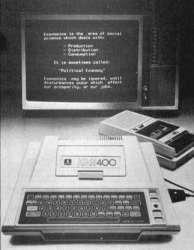Pleasure and business – the AtariBY DAVID BANNISTERThe Atari 400 and 800 personal computers blend business with pleasure; they combine sophisticated game-playing facilities with the potential of a business computer. David Bannister looks at the tradition which produced these machines and assesses them from the hardware and software angles. |
 |
SEVERAL YEARS ago, computers were large boxes operated by highly-qualified staff in white coats. Today, you can buy a computer in the High Street. The general feeling among those who did not work with computers was that those who did were rather dull, but exceptionally clever with numbers. That, of course, was nonsense; some of them were dull, others had highly-developed senses of humour. Also, not all of them were all that clever, though some naturally were. It is those who were both clever and good-humoured who concern us. When these fellows were not calculating the flight paths of lunar probes, they honed their programming techniques on devising assorted games for themselves. By today's standards, these were crude — since most of them printed out messages at a Teletype, there were no mobile graphics displays. |
The main difference was that they did not work in real time. This is the jargon way of saying that the results of the actions of the player were given in separate batches, rather than as the continuous display we see on modern games. As the cost of electronics dropped and its speed increased, it became possible to add the now-familiar TV display. Again, this was still not in real time usually, since the computer was being used most of the time for the serious purpose for which its owners had bought it and its attention was only rarely diverted to a game. This meant it was possible to make your spaceship burn some fuel and have to wait five or 10 minutes before a response appeared on the screen. Nowadays, once the computer has decided what to tell you, it could tell you faster on the TV display than on the printer. I once waited half an hour during a game of Star Trek, only to be told that I had been destroyed by Klingon attacks. |
Transforming factorThe factor that transformed computer games was the general availability of the microprocessor. Despite what people say about the chip, the good thing about microprocessors is that it means computing ability is inexpensive. Everybody can use them — in real time, too, which makes it easier to model reality. Video machines are just computers dedicated to one specific task.Games today are still essentially the same as those which were being played — and still are — in computer installations 10 years ago, but the machines have improved and become more widely available. There are two types of videogame computer. There are those which play a selection of games — perhaps 10. Usually, they are tennis- and battle-type games. Although they were initially very expensive, manufacturing for today's mass market has led to a dramatic drop in price — just as it did with calculators. |
The second type is the programmable game, which is still rather more expensive. By "programmable", we mean the kind of machine on which the user can write programs for himself. Television advertising suggests that some machines can be "programmed" by the insertion of assorted cartridges; these machines do not concern us here. The most obvious examples of these fully-programmable machines are the personal computers to be seen in most department stores or electrical shops. Most have the ability to do whatever the user tells them, with varying degrees of usefulness. What separates them into the market sectors to which each is sold is the software or programs available from manufacturers. Some manufacturers choose to sell their machines as business tools and provide, say, accounting software, while others are sold as games machines — often accompanied by educational material. Certain technical factors contribute to which market a particular machine attracts — style is often important in this. |
Economic reasonsA few machines have tried to make the transition to become a truly general-purpose computer. There are sound economic reasons for any manufacturer attempting to create such a machine — you have a bigger market and can sell more machines. It seems that when planning products, companies assume that every family conforms to the statistical norm and has 2.4 children, a certain income and Daddy makes all the decisions.Part of the rationale behind making a computer which is both a videogames machine and a business machine is that the father can justify the expense of buying the kids a toy by using it as a serious computer. Having had an Atari 400 and an Atari 800 at home for some time, I can assure anyone thinking along those lines that they will be playing the games with the children — or rather, instead of the children. |
Of the 10 or so people who visited my home while these machines were there, three were computer programmers, one was a dentist, two were doctors and none showed the slightest interest in anything other than one particular videogame called Star Raiders. The major difference between the 400 and the 800, apart from price, is that the 400 has a touch-sensitive keyboard while the 800 has proper keys; the 400 also has a more limited memory size. Supplied with the machines were two floppy-disc drives, a tape recorder — a floppy disc is much faster for the storage of programs — and a mountain of software. The machines have 48K of memory, which means that there is a good deal of capacity to hold software. Lifting a flap on top of the machine reveals a slot — two slots in the case of the 800 — into which program cartridges can be plugged. This is the third method of entering software into the Atari. |
As far as game playing is concerned, the disc drive seems redundant since most of the games from Atari are on either tape or cartridge. The disc drives seem to be a concession to the notion of serious business use. Discs are very useful in most business applications; in effect, they are the system's filing cabinet. In the case of the Atari system, I found them to be rather difficult to integrate into a program — which may have been my fault for attempting to use commands with which I was more familiar, but which the machine did not seem to recognise. In my defence, I would say that the manual for the drives is not helpful. |
The tape drives are a joy. Loading a program from tape can be a tedious procedure, since it takes a considerable time for a program of any useful length. While loading, the Atari plays a soundtrack and a pleasant American voice gives useful instructions. My only complaint is that the tune is the same on each of the cassettes, and it becomes very irritating. Having both the digital information of the program and an audio soundtrack is very useful for educational programs. One of the cassettes is a tutor in the Basic computer language, designed to enable anyone who has bought the machine to learn to program. This particular tutor is very impressive, since it can "talk you through". |
In fact, most of the educational software is of a better standard than I have often seen. For example, there is a geographical tutor which draws the states of the U.S.A. and asks you to name them, and their capitals. Because the map is drawn in colour, interest is sustained throughout. It also appealed to adults — I now know that the capital of Florida is not what I though it was. The software, like the hardware, is very well finished. A great deal of thought has obviously gone into dressing programs which would illicit [sic] the best response from the user. |
Star Raiders, as the name implies, is a space game. In fact, it is a greatly-improved version of Star Trek, one of the original computer games. In full colour, with an amazing variety of noises, your starship travels throughout the galaxy destroying assorted aliens who fight back in a most realistic way. It is without doubt the best video or computer game I have seen, and the army of admirers who spent whole nights playing it in my front room will no doubt agree. |
Videogame ageWhich brings us on to the question: "Have videogames come of age"? I have to say that I do not think so. Although assorted technical factors have brought them — at least potentially — in to everyone's reach, there is something about the fact that they are visual games which makes me feel that they have to be made more realistic still.Much is spoken about technology convergence, and with good reason. There are, however, few technologies which have not been integrated with games. When I can buy — or when I can afford to buy — a version of Star Raiders which uses holographic techniques and convinces me I am fighting in galactic space, then I shall say that videogames have come of age. ¨ |
 |